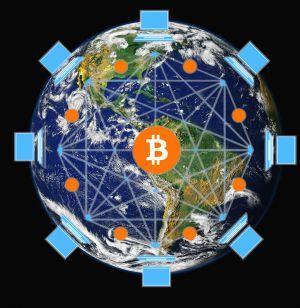How Does Bitcoin Mining Work? Governments create more money when there is a need for additional currency in typical fiat money systems. But in the case of Bitcoin, the new currency is not printed; instead, it is “discovered.” The “mining” for coins involves computers from around the world competing against one another. In a conventional monetary and banking system. Governments and banks have the authority to create additional money whenever they see fit. They frequently do so. However, this is impossible with Bitcoin because it creates new money. Is centered on mining, which is a very ingenious method of confirming Bitcoin transactions. Simultaneously recording them on a decentralized ledger. No one can accomplish this with Bitcoin. How does the Bitcoin mining process work? Within this book, we will go into the principles of Bitcoin mining and the primary mechanisms underpinning it.
What is Bitcoin mining?
Mining for bitcoins, often known as “discovering,” is one definition. Bitcoins, like gold, have an artificially restricted supply; there will never be more than 21 million BTC in circulation. In addition, just like gold, it can only be obtained by investing resources and applying significant effort. On the other hand, Bitcoins were not designed to be mined in the same way that gold was and instead require the combined processing power of millions of computers in different parts of the world.

It can take some time to get your brain around it, but once you do, you’ll realize how brilliant it is. Anyone can operate a Bitcoin node and test their luck at mining, but there is no assurance that either activity will result in a financial gain. See our guide by the same name if you want to learn more about “what is Bitcoin mining.”All you need to understand is that mining Bitcoin serves various purposes.
Protects the Bitcoin network. Encourages miners to contribute their resources to the Bitcoin network by providing them with an incentive to do so. Verifies and validates Bitcoin transactions. Ensures that Bitcoin remains decentralized, thereby transforming it into a free, global peer-to-peer (P2P) form of currency. Creates a scarcity and makes it challenging to acquire bitcoins.
How does mining work?
People can constantly send bitcoins (or any other digital asset), but this activity doesn’t mean much unless someone keeps track of every transaction. This is especially relevant when discussing digital assets, which are very simple to replicate. Therefore, to have digital cash that is completely functional, you need to keep a record of who paid what and to whom. This is essentially what banks do for us so that we may take advantage of their services. How can we stop “double spending,” in which one person sends an identical amount of bitcoins to another? Bitcoin mining is the solution to this problem.
The Bitcoin network takes the place of banks. Other intermediaries process all network transactions, compiling said transactions into a list. And encasing said list within immutable blocks. In the end, the miners are responsible for doing all of the work. Which includes allocating their hashing power to confirm the transactions and recording them on a publicly distributed ledger. To mine Bitcoin, you need a computer. A particular Bitcoin program known as a client. Installing the Bitcoin client software on your personal computer immediately makes you a miner. You can compete with other miners to solve complex mathematical riddles.
What are Bitcoin hashes?
In its most basic form, the distributed public ledger is an extensive list of blocks, each of which contributes to the formation of the blockchain that underpins Bitcoin. The blockchain, also known as the Bitcoin distributed ledger, is a public record of all transactions on the Bitcoin network. Because the file is public, anyone may investigate it using any Bitcoin block explorer. Because of this, which is stored on a fresh block, and they share it.
The miners are responsible for processing a block of transactions once it is complete. They use the SHA-256 Cryptographic Hash Algorithm to turn the information into a hash, a sequence of numbers and letters that looks completely random. To generate a hash out of the data that is part of a Bitcoin block is quite simple. Even if you only alter one of the symbols in the initial input, you will have a completely different hash. As a result, it is mathematically impossible to forecast the production, and the only way to get close to it is to make educated guesses, which is what miners do.
Despite this, the miners do not simply encrypt the transactions using hashes; they also use a few other pieces of data. A single one of these elements is the hash for the previous block. This creates a digital equivalent of a wax seal since the hash of each block contains the hash of the block that came before it. It assures that the newly produced block and each block that came before it is valid.
In other words, a bogus transaction would modify a block in addition to its initial hash. All of the blocks in the chain would be affected by this because the hash of each block is used to generate the hash of the following block. Therefore, if checked, the person doing so would quickly be able to distinguish between correct and fake blocks because the latter do not match the ones already verified on the blockchain.

Competing for coins
We have already established that the only way to close off a block is to predict the output of the hash correctly, and the most efficient way to do so is for computers to guess the output of the hash randomly. Every miner races against the other to see who can use the mining software to guess the answer first.
The block reward is created by taking billions of random computer-generated guesses worldwide. If things continue, the block reward will drop to 6.25 Bitcoin per block at some point in 2021. Simply put, it is an incentive to continue mining so the system can function correctly.

